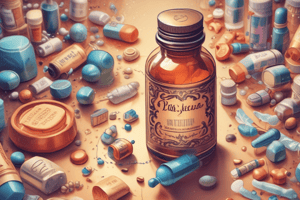Podcast
Questions and Answers
What primarily causes microbial spoilage in pharmaceutical products?
What primarily causes microbial spoilage in pharmaceutical products?
- Chemical reactions within the product
- Growth of microorganisms (correct)
- Environmental factors
- Physical damage to the packaging
Which of the following is NOT a common factor affecting microbial spoilage?
Which of the following is NOT a common factor affecting microbial spoilage?
- Presence of personnel
- Environmental conditions
- Chemical composition of the packaging (correct)
- Nutritional factors
What type of spoilage is caused by the reaction of the product with light?
What type of spoilage is caused by the reaction of the product with light?
- Microbial spoilage
- Physical spoilage
- Enzymatic spoilage
- Chemical spoilage (correct)
Which factor can directly introduce microorganisms into pharmaceutical products during manufacturing?
Which factor can directly introduce microorganisms into pharmaceutical products during manufacturing?
Which type of spoilage specifically involves the degradation by microbial-produced enzymes?
Which type of spoilage specifically involves the degradation by microbial-produced enzymes?
Which of the following nutrients is NOT typically linked to microbial growth?
Which of the following nutrients is NOT typically linked to microbial growth?
Why is it important to control microbial contamination in pharmaceutical products?
Why is it important to control microbial contamination in pharmaceutical products?
Which of the following is an example of physical spoilage?
Which of the following is an example of physical spoilage?
What is the purpose of measuring the water activity (aw) in pharmaceutical products?
What is the purpose of measuring the water activity (aw) in pharmaceutical products?
At what range of temperatures do most microorganisms typically grow?
At what range of temperatures do most microorganisms typically grow?
Why is the pH level important in the formulation of pharmaceutical products?
Why is the pH level important in the formulation of pharmaceutical products?
What type of microorganisms are likely to prefer pharmaceutical products with a high redox potential?
What type of microorganisms are likely to prefer pharmaceutical products with a high redox potential?
Which environmental factor is a primary source of microbial contamination in pharmaceutical products?
Which environmental factor is a primary source of microbial contamination in pharmaceutical products?
How should pharmaceutical products be stored to minimize microbial spoilage?
How should pharmaceutical products be stored to minimize microbial spoilage?
What role does packaging play in the microbial safety of pharmaceutical products?
What role does packaging play in the microbial safety of pharmaceutical products?
What is the most common source of microbial contamination during pharmaceutical manufacturing?
What is the most common source of microbial contamination during pharmaceutical manufacturing?
Which preservative is used in tablets at a concentration of 0.1% w/v?
Which preservative is used in tablets at a concentration of 0.1% w/v?
What is the concentration range for Phenol in injectables?
What is the concentration range for Phenol in injectables?
Which of these is NOT a characteristic of effective preservatives?
Which of these is NOT a characteristic of effective preservatives?
What type of test is performed to evaluate the microbial stability of formulations?
What type of test is performed to evaluate the microbial stability of formulations?
Which formulation has a preservative concentration of 0.002% for Bronopol?
Which formulation has a preservative concentration of 0.002% for Bronopol?
Which preservative can be used in eye drops at a concentration of 0.01%?
Which preservative can be used in eye drops at a concentration of 0.01%?
What is a reason some formulations may not require preservatives?
What is a reason some formulations may not require preservatives?
What is the minimum concentration of test organisms recommended for microbial stability testing?
What is the minimum concentration of test organisms recommended for microbial stability testing?
What is the main purpose of adding chemicals during the viable count of a sample?
What is the main purpose of adding chemicals during the viable count of a sample?
Which type of media is derived from natural sources?
Which type of media is derived from natural sources?
Which stage follows the isolation of tissue in the cell culture process?
Which stage follows the isolation of tissue in the cell culture process?
What distinguishes primary cell cultures from established cultures?
What distinguishes primary cell cultures from established cultures?
What is the main requirement for successful animal cell culture?
What is the main requirement for successful animal cell culture?
What is the benefit of using serum-containing media in cell culture?
What is the benefit of using serum-containing media in cell culture?
Which of the following criteria is considered the most desirable in assessing cell culture performance?
Which of the following criteria is considered the most desirable in assessing cell culture performance?
Which option is most likely to obstruct the growth of microbial cells in a sample intended for viable counting?
Which option is most likely to obstruct the growth of microbial cells in a sample intended for viable counting?
What is the primary purpose of sterilizing tissues with 70% alcohol before isolation?
What is the primary purpose of sterilizing tissues with 70% alcohol before isolation?
Which of the following best describes primary cell culture?
Which of the following best describes primary cell culture?
What occurs during the establishment of a cell line?
What occurs during the establishment of a cell line?
What is a characteristic of transformed cell culture?
What is a characteristic of transformed cell culture?
What method can be used for disaggregating tissue in primary cell culture?
What method can be used for disaggregating tissue in primary cell culture?
What is a primary application of cell cultures in the pharmaceutical industry?
What is a primary application of cell cultures in the pharmaceutical industry?
Which best describes established cell cultures?
Which best describes established cell cultures?
What happens to established cell lines after numerous divisions?
What happens to established cell lines after numerous divisions?
Flashcards are hidden until you start studying
Study Notes
Spoilage of Pharmaceutical Products
- Deterioration of physical, chemical, or biological properties rendering products unusable.
- Caused by microbial contamination, chemical degradation, or physical damage.
Microbial Spoilage
- Most common type, caused by microorganism growth.
- Microorganisms produce toxins, enzymes, and metabolites that degrade active ingredients, alter appearance, and create off-odors and flavors.
- Sources include the environment, raw materials, personnel, and equipment.
Non-Microbial Spoilage
- Chemical spoilage is caused by chemical reactions, such as oxidation, hydrolysis, and photolysis.
- Physical spoilage results from physical damage like breakage, cracking, or crushing.
- Enzymatic spoilage occurs due to enzymes like lipase, protease, or maltase, leading to hydrolysis of liquids.
Factors Affecting Microbial Spoilage
- Nutritional factors: Microorganisms need carbon, nitrogen, phosphorus, sulfur, and vitamins; presence of these nutrients increases spoilage risk.
- Water: Water is essential for microbial growth; higher water activity (aw) in products increases susceptibility to spoilage.
- Storage temperature: Optimal temperature for growth varies, but most microbes thrive between 4°C and 60°C.
- pH: Most microbes prefer neutral or slightly acidic conditions, but some tolerate extreme pH values.
- Redox potential: Aerobic microorganisms prefer high redox potential, while anaerobic organisms favor low redox potential.
- Package design: Packaging should prevent microbial ingress and maintain sterility.
Sources and Types of Microbial Contamination
- Atmosphere: Microorganisms are carried in dust, skin, clothing, moisture, or through coughing/sneezing. Common isolates include bacteria and fungi.
- People: The most common source, with microbes found on skin, hair, clothing, and respiratory tracts.
- Raw Materials: Contaminated water, excipients, and active ingredients can introduce microbes.
- Equipment: Improperly cleaned equipment can harbor microorganisms.
Preservatives
- Used to prevent microbial spoilage in pharmaceutical products.
- Examples include methyl paraben, phenol, benzyl alcohol, thiomersal, bronopol, and alcohol.
- Concentration depends on the formulation and the preservative used.
Preservative Characteristics
- Rapidly kill all microbial contaminants.
- Non-toxic.
- Non-irritant.
- Cost-effective.
- Physically and chemically stable.
Evaluation of Microbial Stability
- Depends on the preservative's effectiveness.
- Chemical and biological assays may ensure effectiveness, but activity can be lost due to other formulation ingredients.
- Some formulations act as self-preservatives or contain antimicrobial agents.
- Microbial stability testing ensures the formulation can resist microbial growth.
- Inoculated products with specific microorganisms are tested at different intervals to determine viable count.
Animal Cell Culture
- In-vitro cultivation of animal cells in a controlled environment with necessary nutrients.
General Procedure for Cell Culture
- Designing animal cell culture media is more complex than for microorganisms or plants.
- Media selection depends on cell type and culture objective.
Culture Media Types
- Natural: Derived from natural sources like plasma clot, biological fluids, and tissue extracts.
- Artificial: Prepared with organic and inorganic nutrients, vitamins, salts, serum protein, carbohydrates, and gases.
Procedure for Cell Culture
- Isolation of tissue: Explant from an animal is surgically removed and surface-sterilized.
- Disaggregation of tissue: Primary cell culture obtained by disaggregating tissue mechanically, enzymatically, or with chelating agents.
- Seeding: Dissociated cells are seeded in culture vessels.
Stages of Cell Culture
- Primary cell culture: Cells are isolated from an organ and grown in vitro.
- Established cell culture: Primary cells are subcultured for 70-80 times, resulting in faster growth.
- Transformed cell culture: Established cell lines become immortal due to genetic transformation, resulting in indefinite growth.
Applications of Cell Cultures in Pharmaceutical Industry
- Drug discovery and development: Screening for efficacy and toxicity.
- Mechanism of action studies.
- Biomarker identification to predict patient response.
Studying That Suits You
Use AI to generate personalized quizzes and flashcards to suit your learning preferences.




